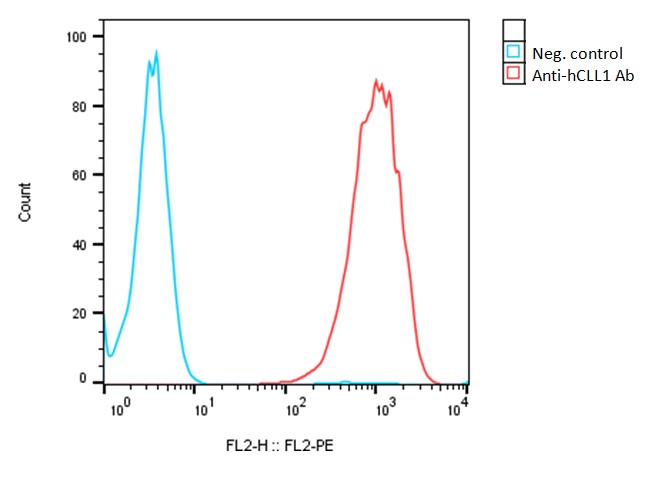
| Catalog Number | Product | Size | Price | |
|---|---|---|---|---|
| C3087 | Human CLL1-CHO-K1 stable cell line | 2 vials | $4950 | Order |
| Catalog Number | C3087 |
|---|---|
| Cell Line Name | Human CLL1-CHO-K1 stable cell line |
| Accession Number | NM_138337.6 |
| Host Cell | Adherent CHO-K1 |
| Quantity | Two vials of frozen cells (2x106 per vial) |
| Culture Medium | DMEM with 10% FBS, 4 ug/ml puromycin |
| Freezing Medium | 90% FBS and 10% DMSO |
| Storage | Liquid nitrogen upon receipt |
| Product Datasheet: | Download PDF |
Detection of human CLL1 expression on human CLL1-CHO-K1 stable cells using a monoclonal antibody specific for human CLL1 (Invitrogen. #12-9878-41)

CLL1, also known as CLEC12A (C-type lectin domain family 12 member A), is a transmembrane glycoprotein and a member of the C-type lectin receptor family. CLL1 primarily functions as an inhibitory receptor, regulating immune cell activation and inflammatory responses. It is involved in the recognition of damage-associated molecular patterns (DAMPs), such as uric acid crystals released during cell damage or stress, and modulates immune reactions by transmitting inhibitory signals to suppress excessive inflammation. Upon ligand binding, CLL1 recruits phosphatases to the ITIM domain, which suppresses the activation of immune cells, including dendritic cells and macrophages. It balances immune responses, preventing overactivation while allowing efficient immune surveillance. This regulation is critical in controlling inflammation and avoiding autoimmune reactions. CLL1 is expressed predominantly on the surface of myeloid cells, including monocytes, macrophages, dendritic cells, and granulocytes. CLL1 is overexpressed in several hematological malignancies, particularly in acute myeloid leukemia (AML). It is highly expressed on leukemic stem cells (LSCs) and leukemic blasts in AML, but absent or lowly expressed in normal hematopoietic stem cells (HSCs), making it a potential marker for leukemic cells. CLL1 is emerging as a promising therapeutic target for leukemia, particularly in AML. Since it is selectively overexpressed in leukemic stem cells and not normal HSCs, it provides a therapeutic window for targeting without affecting normal hematopoiesis.
Tabata R, Chi S, Yuda J, Minami Y. Emerging Immunotherapy for Acute Myeloid Leukemia. Int J Mol Sci. 22(4):1944. 2021.
Morsink LM, Walter RB, Ossenkoppele GJ. Prognostic and therapeutic role of CLEC12A in acute myeloid leukemia. Blood Rev. 34:26-33. 2019.